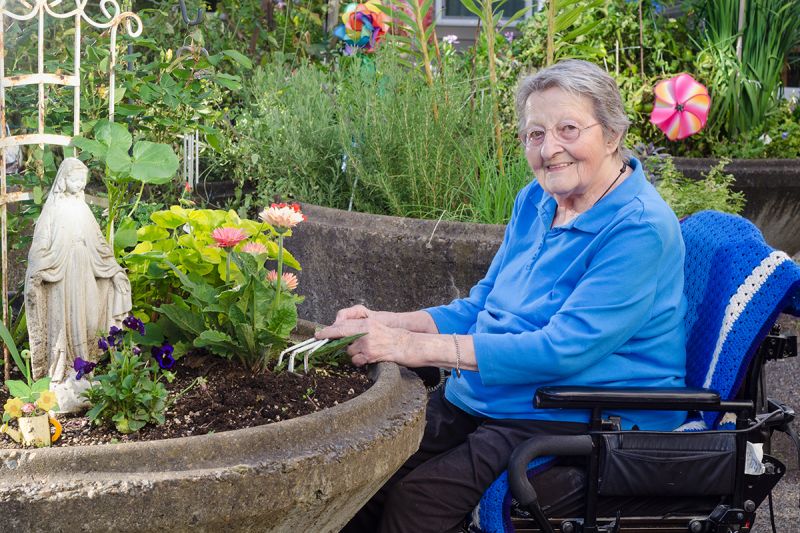How to Make Your Garden Handicap Accessible: Tips for a Beautiful and Inclusive Outdoor Space
Posted: May 29, 2025
Gardens are more than just beautiful outdoor spaces—they're places of peace, therapy, and joy. But for individuals with mobility challenges, traditional gardens can be hard to navigate or even completely inaccessible. Whether you're planning for yourself, a family member, or a visitor, making your garden handicap accessible means everyone can enjoy the sights, scents, and serenity of nature.
Here’s how to create a garden that’s as inclusive as it is inviting.
Here’s how to create a garden that’s as inclusive as it is inviting.
Start with Accessible Pathways
Smooth, wide, and stable pathways are the foundation of an accessible garden. Here’s what to consider:
- Width: Paths should be at least 36 inches wide (48 inches is even better) to accommodate wheelchairs and walkers.
- Surface: Use firm, non-slip materials like concrete, brick, or compacted crushed stone. Avoid loose gravel or uneven pavers.
- Slope: Keep inclines gentle—no more than a 5% slope (1:20 grade) is ideal for wheelchairs.
- Edges: Raised edging or borders help guide the way and keep wheelchairs from slipping off.
Install Raised Garden Beds
Traditional in-ground gardening can be tough for those with limited mobility or chronic pain. Raised beds bring the garden to the gardener.
- Height: Ideal height is 24–36 inches depending on the user’s needs (wheelchair users often prefer 28–30 inches).
- Width: Beds should be no more than 2 feet wide if accessed from one side, or 4 feet if accessible from both sides.
- Material: Use rot-resistant wood, stone, or metal for long-lasting and safe structures.
Choose Easy-to-Reach Planters and Containers
Container gardening is perfect for patios and decks. Use:
- Hanging baskets with pulley systems
- Planters on stands or carts
- Vertical wall planters for herbs and flowers
Make sure they’re positioned at a comfortable height and easily accessible from a seated position.
Incorporate Comfortable Seating Areas
Gardening should be relaxing, not exhausting. Include benches or chairs throughout the space so gardeners can take breaks or simply enjoy the view.
Look for:
Look for:
- Armrests and back support
- Shade from trees or umbrellas
- Clear, stable space around the seating area for wheelchairs or walkers
Use Accessible Tools and Equipment
Many manufacturers now make adaptive garden tools designed for people with arthritis, limited grip strength, or mobility impairments. Features to look for:
- Ergonomic handles
- Long-reach tools for standing or seated gardening
- Lightweight materials
- Tools with wrist supports or arm cuffs
Think About Water Access
Dragging a hose can be a challenge. Make watering easier with:
- Soaker hoses or drip irrigation systems
- Hose reels mounted at wheelchair height
- Rain barrels with spigots and short hoses
- Easy-to-use spray nozzles or watering wands
Add Lighting for Safety and Comfort
If you’ll be gardening in the early morning or evening, good lighting is essential. Install:
- Solar-powered or low-voltage LED path lights
- Motion-sensor or dusk-to-dawn lights around entrances
- Spotlights for key areas like seating or raised beds
Plant with Accessibility in Mind
Choose low-maintenance, sensory-rich plants that are easy to care for:
- Fragrant herbs like lavender, mint, and rosemary
- Brightly colored flowers like zinnias and marigolds
- Soft, textured foliage like lamb’s ear
- Edibles like cherry tomatoes, strawberries, or lettuce
Avoid prickly, poisonous, or high-maintenance plants.
Reduce Trip Hazards and Obstructions
Keep the garden neat and tidy to minimize hazards:
- Trim overhanging branches or sprawling plants
- Keep tools and hoses stored safely
- Avoid clutter or sharp-edged decorations near paths
Design with Joy in Mind
Above all, make the garden a place of joy, reflection, and connection. Incorporate personal touches:
- Wind chimes, bird feeders, or fountains
- A favorite color scheme or themed section
- Raised beds in the shape of initials, hearts, or spirals
Accessibility is about more than compliance—it’s about creating spaces where everyone feels welcome and included.
Final Thoughts from Senior Communities Guide
An accessible garden is not just a functional space—it's an act of care and inclusivity. By planning with mobility in mind, you open the door to healing, independence, and the simple pleasure of digging in the dirt. With thoughtful design and a few adjustments, anyone can enjoy the magic of gardening.
